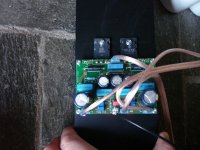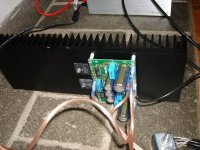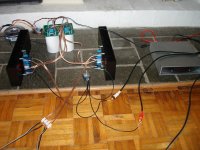My simple prototype has a quite sweet treble too. I attribute that to the Class A mostly and like it. The Musical Fidelity A1 was also that way but it is not that extreme. Maybe it is the 2nd harmonic.
My simple prototype has a quite sweet treble too. I attribute that to the Class A mostly and like it. The Musical Fidelity A1 was also that way but it is not that extreme. Maybe it is the 2nd harmonic.
Yeah I'm not comfortable with the HF distortion either, but it doesn't disturbing soundwise.
May be part of the reason is because the weakest link is usually in the tweeter and we get used to listening unnatural trebles (besides, there is no music there either).
But as a push-pull amplifier, the TSSA behaves like a single-ended amplifier. Nice harmonics, and look at that phase behaviour! Very little increase in THD with increasing power. In the past, this is perceived by many as the characteristics of good amplifiers.
There is a way to get the second harmonic away ( e.g. not totally ).
Use two TSSA amplifiers in a balanced setup per channel. I would do it with a Thats chip or even better with a transformer but then a good one is expensive.
Use two TSSA amplifiers in a balanced setup per channel. I would do it with a Thats chip or even better with a transformer but then a good one is expensive.
Do you really want to do that, Joachim?
There is the psychoacoustic masking effect of a small H2 component.....
Hugh
There is the psychoacoustic masking effect of a small H2 component.....
Hugh
I do not worry about the second.
In a listening test done at Prof.Dr.Klippel i could not hear better then 1% THD, no matter how hard i tried. On second harmonic alone i did even much worse.
That was done over headphones with a clean signal as reference.
I just wanted to talk about that option, just in case.
Here is the Thats chip i am talking about :http://www.thatcorp.com/datashts/THAT_1606-1646_Datasheet.pdf
That adds also some gain that may be useful or not.
My preferred way of doing it would be a transformer, unfortunately the best ones from Lundahl cost around 150,-€ each.
In a listening test done at Prof.Dr.Klippel i could not hear better then 1% THD, no matter how hard i tried. On second harmonic alone i did even much worse.
That was done over headphones with a clean signal as reference.
I just wanted to talk about that option, just in case.
Here is the Thats chip i am talking about :http://www.thatcorp.com/datashts/THAT_1606-1646_Datasheet.pdf
That adds also some gain that may be useful or not.
My preferred way of doing it would be a transformer, unfortunately the best ones from Lundahl cost around 150,-€ each.
Last edited:
There is another way to isolate distortion :Distortion Isolation in the Time Domain
I worked with Bill Waslo on this in 2006. It also works with amplifiers.
It did not catch up much though unfortunately.
Endless debate what is audible or not, mostly anecdotal : YES
Using serious research to find out the limits of the human ear : NO
I worked with Bill Waslo on this in 2006. It also works with amplifiers.
It did not catch up much though unfortunately.
Endless debate what is audible or not, mostly anecdotal : YES
Using serious research to find out the limits of the human ear : NO
There is a way to get the second harmonic away ( e.g. not totally ).
Use two TSSA amplifiers in a balanced setup per channel. I would do it with a Thats chip or even better with a transformer but then a good one is expensive.
Many DACs give a balanced o/p so going balanced from DAC to Speakers is in fact the simplest option - I will be testing this option later this year.
I guess if you need transformers you have either have a S/E o/p DAC or an analogue S/E source.
There is a way to get the second harmonic away ( e.g. not totally ).
Use two TSSA amplifiers in a balanced setup per channel. I would do it with a Thats chip or even better with a transformer but then a good one is expensive.
I will try that idea. First with many small input transformers that I have on hand (but never tried to find out how bad they really are). Next, with JFET circuit (the TSSA benefits from such circuit in the input)
There is the psychoacoustic masking effect of a small H2 component.....
Hugh, what do you mean by that? Is that something bad? Do you mean that if the H2 is removed/reduced then it will not sound as nice because the 3rd order (and above) harmonics (which is dominant at HF) become audible?
F5 has the capability (balancing the FB) to tune in 2nd harmonics but it seems many prefer the "clean" version. And in term of distortion spectrum I see the TSSA is not different than the F5.
Do you really want to do that, Joachim?
There is the psychoacoustic masking effect of a small H2 component.....
Hugh
Yeah, for most systems cancelling 2nd HD may not be the prime motivation for going balanced but I suspect there may be other sonic advantages connected with earthing & noise levels.
. . . and some people think dominant H3 sounds best 😀
Yes i do.
The boards are 75mu copper, and NiAu plated.
The boards without SMT Will cost 21€ each.
With SMT They Will cost 39€ each.
With All parts They Will cost 103€ each and it is without heatsink.
I Can also deliver Them assembled and testet on a heatsink.
This is for the TSSA board only.
The psu board needs to be calculated.
It May Sound expensive but there is No cheap parts in this one. Only good quality parts.
Hi Sonnia ,
I received yesterday transistors, thanks

I want to buy 2 PCB + all parts.
Best regards🙂
Good idea to go balanced from DA to speakers.
I use mostly vinyl though. I design phono stages professionally and for DIY, so this is unavoidable.
One benefit of a balanced amp i was told is that pollution from the PSU into ground does not reach the speakers. My TSSA prototype is dead silent though, it does not even have on ON-Off thump.
I use mostly vinyl though. I design phono stages professionally and for DIY, so this is unavoidable.
One benefit of a balanced amp i was told is that pollution from the PSU into ground does not reach the speakers. My TSSA prototype is dead silent though, it does not even have on ON-Off thump.
Great silence is normally attributed to an exceptional design of power supply and many star supply as well as ground points. Clean power is the only formula for a dead silent amp. That is why you cannot beat a primary cell (Battery).
Hi all.
They have been working for 4 days with no issues at all.
Beautiful soundstage.
No noise at all.
No pop on noise.
Some asked for the price on an assembled unit. It is a bit more expensive as they need a larger heatsink.
The price is €253/channel or just go to.
SITO Audio - diyAudio
It is visible to the public yet. Jason needs to make it visible.....
They have been working for 4 days with no issues at all.
Beautiful soundstage.
No noise at all.
No pop on noise.
Some asked for the price on an assembled unit. It is a bit more expensive as they need a larger heatsink.
The price is €253/channel or just go to.
SITO Audio - diyAudio
It is visible to the public yet. Jason needs to make it visible.....
Attachments
Hi guys 
Superb activity going on in TSSA thread, very nice. 😉
Sonny very professional TSSA modules you offered, from plain PCB to assembled module I like it, maybe I'll ordered the second option - PCB with SMT parts assembled.
Will you test TSSA also with the driver mosfets? I think it will be to some extent better than without them.
BTW I finally designed all three CSA boards including real panel PCB which will save me from a lot of seaprate wires at assembly phase, only 20 pin flat cable speedy connector to CSA soft start PCB and voila here we gooo. 😀

Superb activity going on in TSSA thread, very nice. 😉
Sonny very professional TSSA modules you offered, from plain PCB to assembled module I like it, maybe I'll ordered the second option - PCB with SMT parts assembled.
Will you test TSSA also with the driver mosfets? I think it will be to some extent better than without them.
BTW I finally designed all three CSA boards including real panel PCB which will save me from a lot of seaprate wires at assembly phase, only 20 pin flat cable speedy connector to CSA soft start PCB and voila here we gooo. 😀
- Home
- Amplifiers
- Solid State
- TSSA - The Simplest Symmetrical Amplifier


